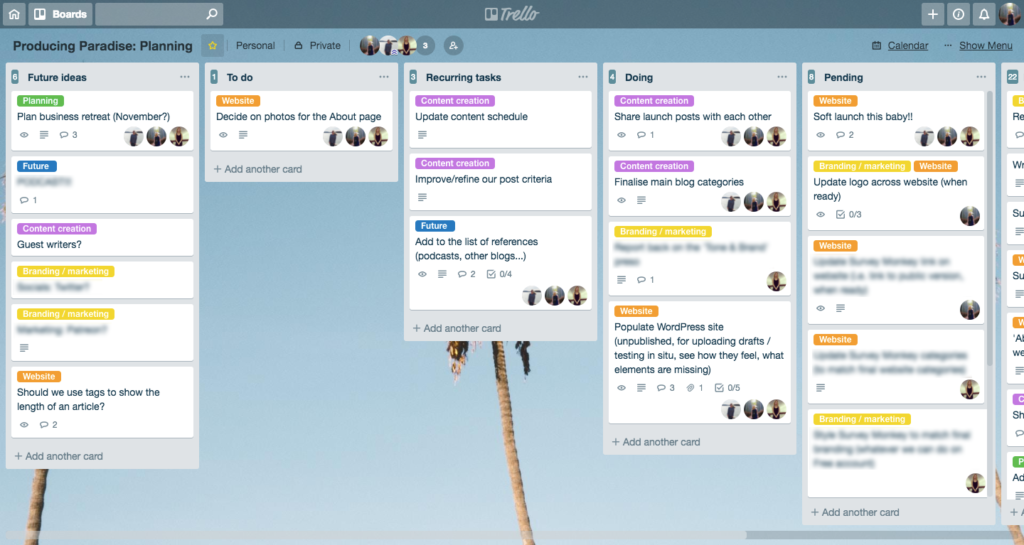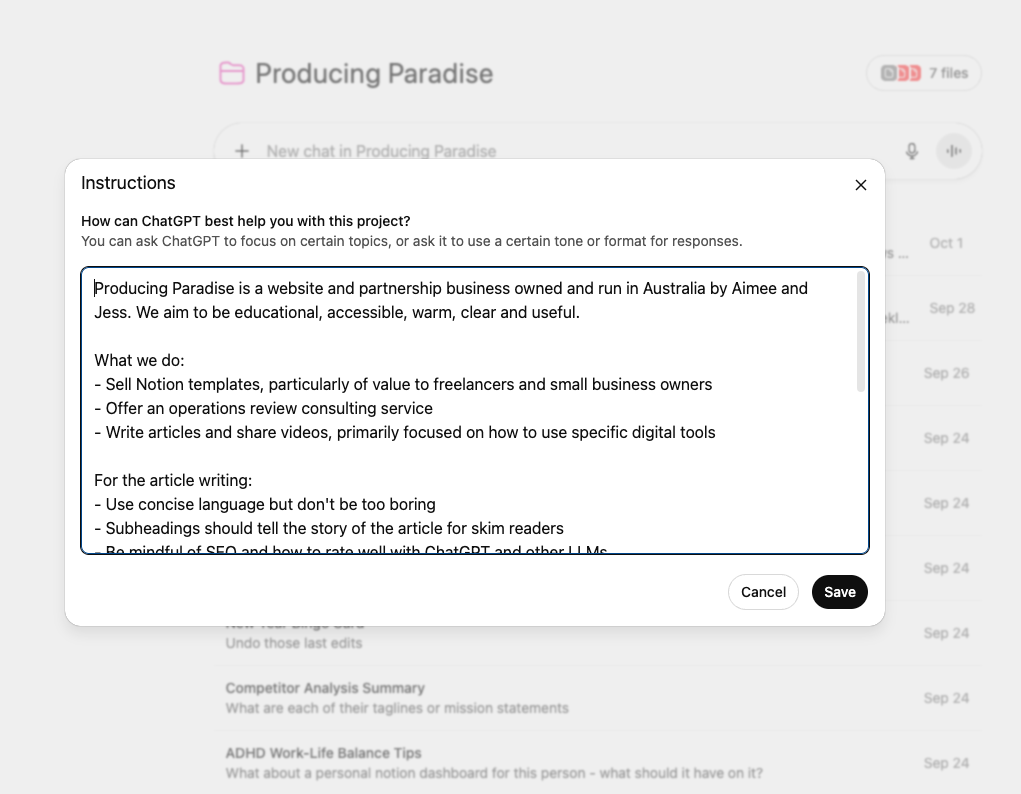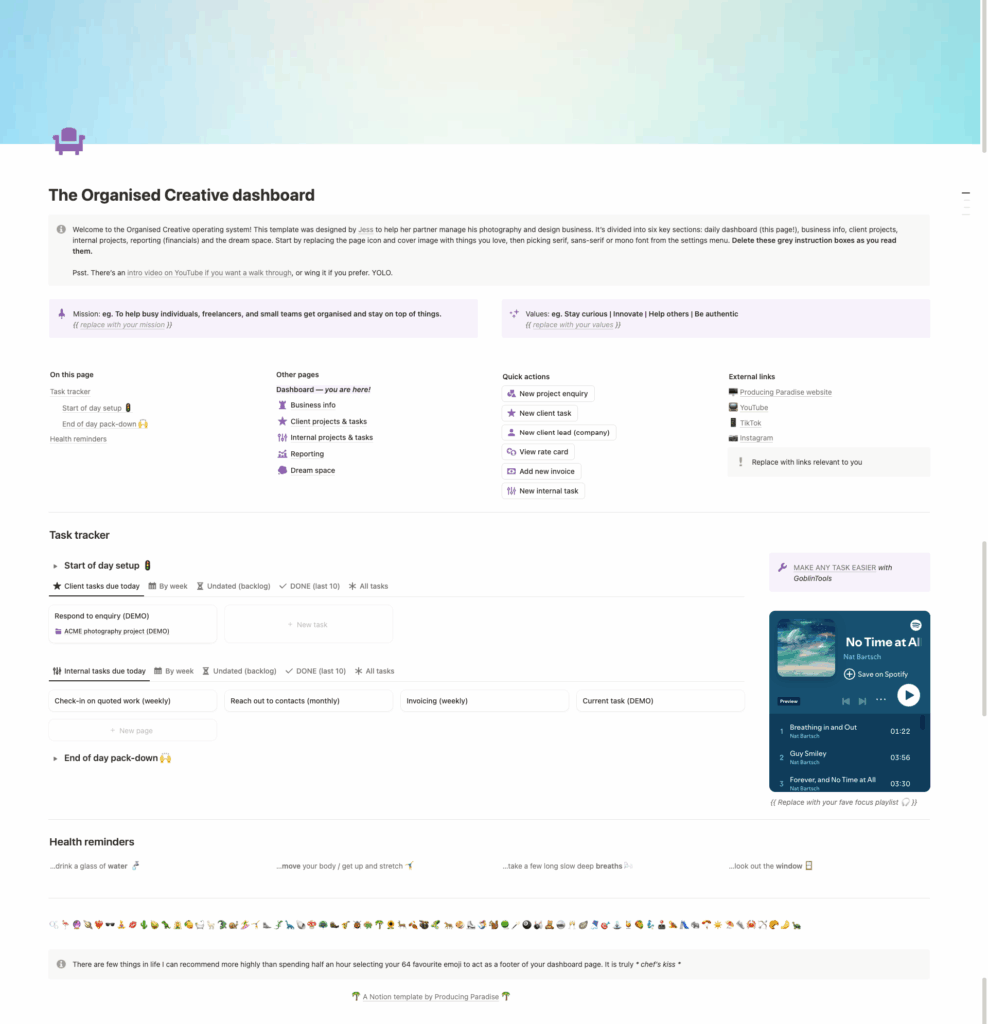The Notion and ChatGPT system I use to run my small businesses, support my partner’s freelance work, and manage life admin—without losing track of anything.

Summary: Notion holds everything: content calendars, business pipelines, project tasks. ChatGPT handles friction points: summarizing drafts, reframing emails, debugging errors. Use it only for clarity and speed, never for generating content. Start with one Notion page and one specific ChatGPT task.
I’ve been through a lot of productivity systems.
Trello in the early days. Then Notion when I wanted more flexibility. Different templates, different workflows, different ways of organizing projects across my small businesses with Aaron and Aimee, plus Aaron’s freelance photography work.

The latest iteration isn’t a new tool. It’s adding ChatGPT alongside Notion—but only for specific things. The stuff where I’d normally get stuck or slow down.
I’m not using it to generate content or churn out AI slop. I’m using it the way you’d use a second opinion: when I need clarity, when I’m debugging something, when I want to test an idea before committing to it.
This is what that looks like in practice.
Producing Paradise: my small business content engine
Every article for this site lives in a Notion database. Status, publish date, category—all there. We can filter by “in progress” or “needs editing” without scrolling through a folder of mysteriously named docs.
Producing Paradise is one of my small businesses, run with my partner Aimee. Our Notion hub keeps the editorial workflow from becoming chaos. We often have multiple article drafts in play at the same time, so the Notion database lets use prioritise and schedule to help sharpen our focus.
ChatGPT comes in during the weird in-between moments. We’ll finish a draft and realise we need the tl;dr summary for the top. We paste in the article and ask for a three-sentence summary. It gives us something workable in ten seconds. Sometimes we keep it. Sometimes we rewrite it. Either way, we’re not staring at a blank text box trying to condense 1,200 words while our brains may not be at full capacity (cough, parenting a toddler, cough).
We also use it for titles when we’ve written ourselves into a corner. “Here are five ideas” usually includes one good one and four terrible ones. But that’s enough.
Pro tip: The ChatGPT project folder can save instructions specific to that project, so you don’t have to repeat yourself.


Aaron Puls Photography: supporting Aaron’s freelance business
Aaron runs a freelance photography and design business. For years, his “system” was emailing himself tasks that would disappear into an overstuffed inbox. We’d be eating dinner and he might say “Wait, did I follow up with that architect?”
I help out with the business side when I can, and now we use a Notion board to track it all. Every lead, every pitch, every follow-up is there. We can see what’s in “initial contact,” what’s moved to “proposal sent,” what’s gone cold.
More recently we’ve added ChatGPT into the mix for some of the thinking work. We’re not marketers. When we need to email a potential client, we write something that may sound stiff and formal because we’re focused on getting the facts down.
So we paste it into ChatGPT and ask: “How would you make this sound less like a sales pitch and more like a person?” It usually suggests something warmer. Last time it told us to cut the entire first paragraph. It was right.
We also use it to test ideas. “Should we pitch this as ‘architectural photography’ or ‘property photography’?” It’ll explain the connotations of each, and we’ll pick based on who we’re talking to. It’s like having a strategy session with someone who’s read every marketing article on the internet but doesn’t charge $200 an hour.

ParentShift: managing our app business when code breaks
ParentShift is a parenting app Aaron and I built together—another of my small businesses. We are a small team, and Notion is where we track features, bugs, and what we’re working on this week. It’s simple. It’s boring. It works.
This is also where the Notion and ChatGPT system stretches beyond admin into coding support. I’ve been vibe coding on Replit AI, but use ChatGPT to debug when things break. And things break constantly.
Two weeks ago I hit a bundling error that made no sense:
Unable to resolve “../../../shared/date-utils” from “app/(tabs)/history.tsx”
It looked like gibberish, and I couldn’t tell if the issue was my code, my imports, or something broken deeper in the stack.
I pasted it into ChatGPT. It explained that the error usually means the file path isn’t resolving properly, and suggested checking whether the relative import was pointing to the right location. It turned out I was reaching up one directory too many. Fixing the path cleared the error instantly.
Sometimes it’s wrong. It may confidently tell me to fix something that isn’t actually broken. But even when it’s wrong, it’s faster than trawling Stack Overflow threads from 2014.

Why it works (and where it doesn’t)
This system isn’t magic. It’s just two tools doing what they’re good at.
Notion is good at holding things. Tasks don’t vanish. Projects don’t get forgotten. I can open it at 9pm and know exactly where I left off.
ChatGPT is good at removing friction. When I’d normally stop and think for ten minutes, I may ask it for input. Sometimes the answer is perfect. Sometimes it’s a starting point. Sometimes it’s completely wrong and I figure it out myself while explaining why it’s wrong.
Together, they mean I spend less time hunting for information and more time doing the most impactful work.
But let’s be honest about what doesn’t work:
- ChatGPT can’t prioritize for you. It’ll happily help you plan seventeen things when you should be doing two.*
- Notion gets messy if you don’t maintain it. I have a “Future article ideas” category that’s basically a junk drawer at this point.
- If you don’t like typing, this system will drive you nuts. Everything runs on writing things down and asking questions.
*I’ve created a Notion task support system to fend against this one!
How to build your own version
You don’t need to copy my setup exactly. You need one home base and one way to reduce friction.
Start with a single Notion page. Just one page where you put the things you need to track. For me that was articles. For you it might be client projects or daily tasks or ideas for your business. You can start from scratch or use a template—whatever gets you moving faster.
Use it for a week. If it feels helpful, add one more thing. If it feels like a chore, simplify it.
Then pick one specific thing you want ChatGPT to help with. Not “everything.” One thing. Summarizing meeting notes. Rewriting emails. Explaining error messages. Get good at that before you add more.
The mistake I see people make is trying to build the perfect system on day one. You don’t need perfect. You need something that works on Tuesday when you’re tired and can’t remember what you’re supposed to be doing.
Want a head start? We’ve built Notion templates that reflect how we actually work:
- Personal dashboard (ADHD friendly) – A free template I designed for Aaron, kept purposefully simple with one task database and a daily triage process. Works for work or home tasks, especially if your brain prefers less visual noise.
- The Organised Creative operating system – A paid template for solopreneurs and freelance creatives (photographers, designers, illustrators) who need help structuring operations and managing projects without drowning in admin.
Things people ask me about this
Can’t I just use Google Sheets instead of Notion?
Sure. If Sheets works for you, use Sheets. The point is having one place, not a specific app.
Doesn’t this take forever to set up?
My first Notion page was a list of article titles with checkboxes. That took two minutes. I added more structure as I needed it.
Do I need paid versions?
It’s not necessary, but there are benefits. I pay for Notion and ChatGPT Plus because I use them so often, but the free versions would work fine for most of this.
What if I don’t want AI involved in my work?
Then don’t use ChatGPT. Notion alone still solves the “where did I put that thing” problem.
Is this just a fancy to-do list?
Kind of, yeah. Except it’s a to-do list that talks to a smart assistant, which turns out to be pretty useful.